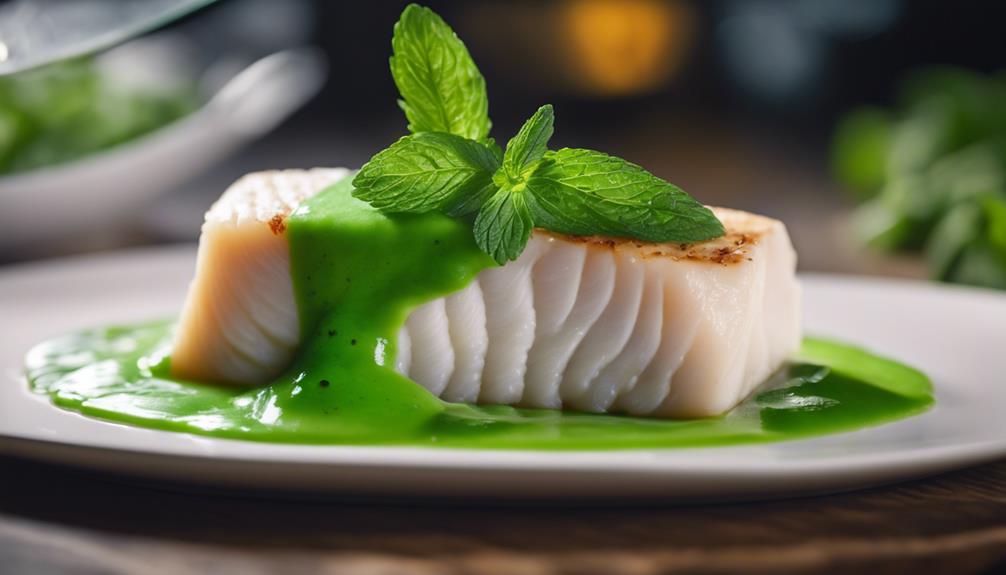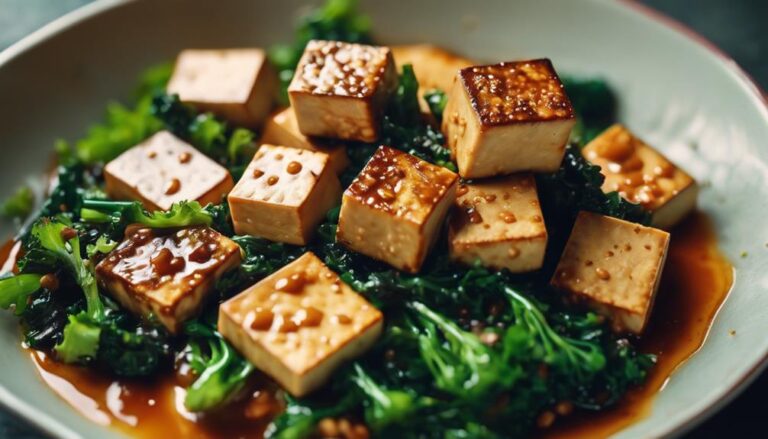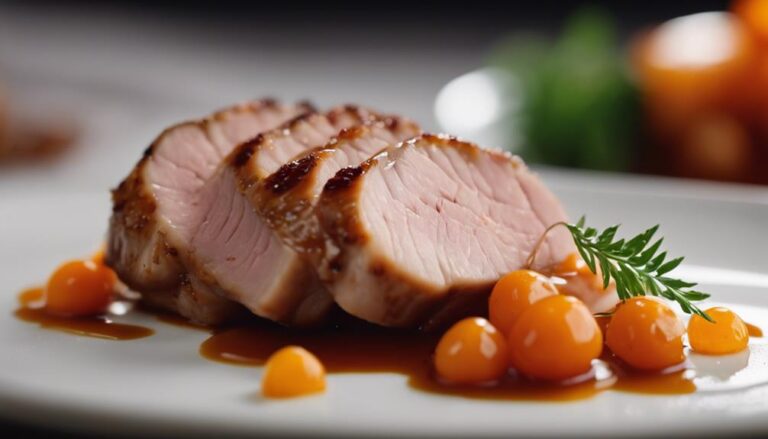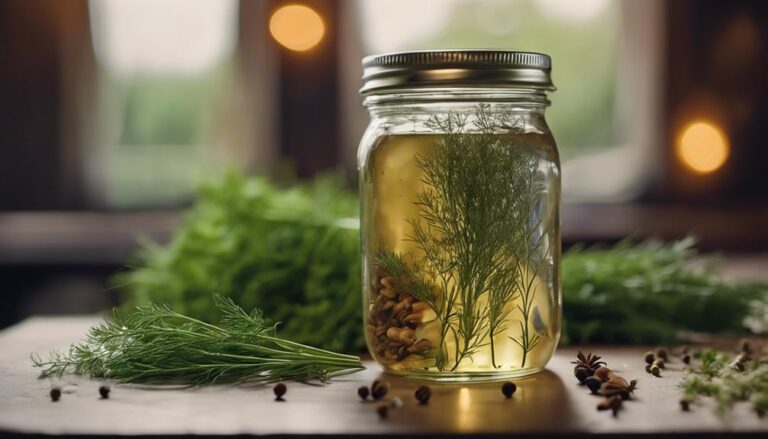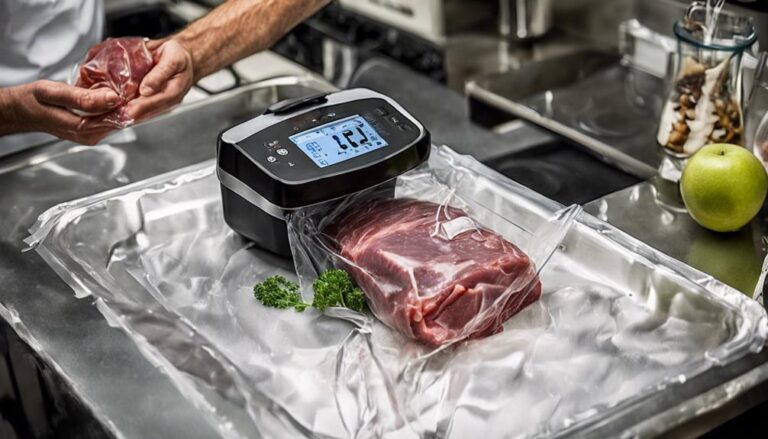Sous Vide Halibut With Pea and Mint Puree
Immerse halibut in a sous vide bath for unparalleled tenderness. Pair it with a velvety pea and mint puree that bursts with freshness and complexity. The sous vide method guarantees precise cooking perfection, locking in flavors and juices. Searing briefly afterward imparts a delightful crispness to the halibut's exterior, a must for texture enthusiasts. The mint heightens the pea's sweetness, complementing the halibut's delicate taste flawlessly. This dish offers a symphony of flavors and textures that will leave you wanting more. Get ready to savor a culinary journey filled with delectable sensations.
What You Will Learn Here
- Sous vide cooking ensures perfect tenderness and flavor retention in halibut.
- Pea and mint puree adds a refreshing and vibrant taste to the dish.
- Combination of peas and mint creates a harmonious flavor profile with the halibut.
- Achieve buttery soft halibut texture through precise sous vide cooking techniques.
- Cost-effective dish at $10.60 per serving, making it a budget-friendly gourmet option.
Halibut's Origin Story

Halibut, a versatile flatfish species, thrives in the cold waters of the North Atlantic and North Pacific oceans. Its popularity in culinary dishes stems from its lean profile, delicate flavor, and firm texture, making it a sought-after ingredient in various cuisines.
The name 'halibut' itself hints at its historical significance, possibly linked to religious observances and special occasions.
Halibut Species Diversity
With origins tracing back to the depths of the North Pacific and North Atlantic oceans, the diverse species of halibut have captivated both fishers and epicureans alike. Halibut, belonging to the Pleuronectidae family, are renowned for being white fish with a mild, sweet flavor and a firm, flaky texture.
The two main types, Pacific halibut (Hippoglossus stenolepis) and Atlantic halibut (Hippoglossus hippoglossus), offer distinct characteristics to culinary enthusiasts. Pacific halibut, commonly consumed and found along the North Pacific coast, provides a delectable dining experience. In contrast, the larger Atlantic halibut, residing in the North Atlantic Ocean, faces the threat of overfishing, making it a more vulnerable species.
These differences in species contribute to the rich tapestry of halibut's appeal in gastronomy.
Halibut Fishing Regions
Exploring the pristine waters of the North Pacific Ocean reveals a domain teeming with halibut fishing regions that serve as the cradle of this coveted flatfish's legacy. Pan out, and you'll find Alaska, British Columbia, and the Pacific Northwest as key players in the halibut fishing industry. These regions not only boast abundant halibut populations but also showcase sustainable management practices that safeguard the future of this prized fish.
Commercial halibut fishing, particularly in Alaska, not only supports local economies but also provides seafood enthusiasts with premium halibut meat known for its firm texture and mild flavor. Through longline fishing methods, where baited hooks are strategically placed along the ocean floor, fishermen bring in these delectable flatfish, ensuring a fresh catch for your next culinary adventure.
Culinary Uses of Halibut
Teeming with versatility and prized for its firm white flesh and mild, sweet flavor, halibut has secured its place as a culinary delight in kitchens worldwide.
When it comes to culinary uses, pan-seared halibut stands out as a favorite preparation method among chefs and home cooks. The technique of pan-searing allows the fish's meaty texture to shine, creating a beautifully golden crust while keeping the flesh moist and tender.
The mild taste of halibut pairs perfectly with a variety of seasonings and sauces, making it a versatile option for different flavor profiles. Whether seasoned simply with salt and pepper or dressed up with a vibrant citrus salsa, pan-seared halibut never fails to impress with its delicate yet satisfying taste and texture.
Halibut's Key Ingredient Characteristics

Halibut's key ingredient characteristics showcase its reputation as a lean, versatile fish prized for its firm texture and mild flavor profile. Here are four essential points to highlight its culinary appeal:
- Nutrient-Rich Profile: Halibut is packed with omega-3 fatty acids, vitamin B12, and selenium, making it a nutritious choice for those seeking essential nutrients.
- Low Calorie and Fat Content: For health-conscious individuals, halibut stands out as a low-calorie and low-fat protein option that doesn't compromise on flavor.
- Cold Water Origins: Found in the North Pacific and North Atlantic oceans, halibut's habitat contributes to its unique taste and texture.
- Sous Vide Excellence: Halibut's firm texture and moisture retention make it an ideal candidate for sous vide cooking, preserving its delicate flavor and ensuring a moist outcome.
Understanding these key characteristics of halibut sets the stage for appreciating its culinary versatility and health benefits.
Halibut With Pea Puree Variations
When it comes to enhancing your halibut dish with pea puree, consider trying out variations like adding basil or parsley for a unique twist.
You can also experiment with a splash of white wine to bring a touch of acidity to the pea puree.
For a creamier texture, blending in Greek yogurt or sour cream can provide a rich and smooth consistency.
Sous Vide Halibut Method
For ideal tenderness and flavor when cooking sous vide halibut, it's vital to maintain a precise temperature of 50°C (117°F) throughout the process. Here are some key tips to perfecting your sous vide halibut method:
- Season the halibut with salt and pepper before vacuum-sealing it.
- Guarantee the water bath is precisely heated to 50°C (117°F) for consistent cooking.
- Submerge the sealed halibut in the water bath and let it cook for 30-35 minutes.
- Monitor the temperature carefully to prevent overcooking and ensure the fish retains its moisture and delicate texture.
Following these steps will guarantee a beautifully cooked sous vide halibut that pairs perfectly with the vibrant pea and mint puree.
Minted Pea Puree Variation
Enhance your sous vide halibut dish with an invigorating twist by incorporating a minted pea puree variation.
- Fresh Flavor: Minted pea puree adds a fresh and vibrant flavor profile to your halibut.
- Complementary Tastes: The mint complements the natural sweetness of the peas in the puree, creating a harmonious blend.
- Enhanced Presentation: This variation not only elevates the taste but also enhances the overall presentation of your dish.
- Customizable Mint Intensity: Easily adjust the amount of mint in the pea puree to suit your personal preferences for a tailored experience.
With its colorful and flavorful contrast, the minted pea puree adds a burst of freshness that beautifully complements the tender sous vide halibut, creating a delightful culinary experience.
Minted Pea Puree Twist
Consider infusing a touch of mint into your pea puree to create a revitalizing twist for your halibut dish. The minted pea puree brings a fresh and vibrant flavor that beautifully complements the delicate taste of the halibut. Here are some enticing reasons to try this minted pea puree twist:
- The combination of peas and mint offers a harmonious balance of flavors.
- Customizing the pea puree with additional herbs or spices allows for personalization.
- Versatile and adaptable, minted pea puree is an excellent accompaniment for various seafood and meat dishes.
- The smooth texture of the pea puree enhances both the presentation and taste of the halibut, elevating your dining experience.
Searing for Crispy Texture
When searing halibut post sous vide, you'll appreciate the contrast of the crispy exterior against the tender flesh. Achieving that perfect sear not only adds a delightful crunch but also intensifies the dish's flavors.
Searing Technique Benefits
Ever wondered how searing transforms your sous vide halibut into a tantalizing masterpiece with a perfect crispy texture?
Searing your halibut on medium heat after sous vide cooking is the key to achieving that delightful crunch on the outside. This process triggers the Maillard reaction, intensifying the halibut's flavor profile and creating a beautifully caramelized surface.
Not only does searing add complexity and depth to your dish, but it also offers a satisfying contrast in textures – the tender interior against the crispy exterior.
Additionally, the visual appeal of a well-seared halibut is undeniable; the golden-brown crust makes the dish more appetizing and visually inviting, setting the stage for a culinary experience that pleases both the palate and the eyes.
Achieving Crispy Exterior
To achieve a crispy exterior on your halibut after sous vide cooking, searing in a hot pan is essential for creating a golden-brown crust without compromising the fish's texture.
Heat a sauté pan over medium-high heat and add a thin layer of oil to coat the bottom. Gently pat dry the halibut fillets with a paper towel to remove excess moisture, aiding in achieving a more even browning effect.
Once the pan is hot, carefully add the halibut fillets, presentation side down, ensuring they aren't overcrowded. Allow the fillets to sear for about 1-2 minutes per side or until a beautiful golden crust forms.
This quick sear will enhance the flavor and texture of your halibut, elevating your dish to perfection.
Texture Enhancement Tips
For ideal texture enhancement in your sous vide halibut dish, achieving a crispy exterior through searing is paramount. After the gentle sous vide cooking, searing the halibut in a pan over medium heat is where the magic truly happens.
As the fish makes contact with the hot surface, the Maillard reaction kicks in, creating a symphony of complex flavors and a beautiful golden-brown crust. This quick sear caramelizes the surface, providing a delightful contrast to the moist, tender interior of the halibut.
Not only does searing elevate the texture, but it also adds that visually appealing finish that makes your dish irresistible. So, grab your pan, heat it up over medium heat, and get ready to transform your halibut into a crispy masterpiece.
Final Thoughts
Considering the impeccable tenderness and flavor balance achieved through sous vide cooking, the final touch of the pea and mint puree elevates this halibut dish to a culinary masterpiece. The subtle sweetness of the peas combined with the invigorating hint of mint creates a symphony of flavors that harmonize beautifully with the delicate halibut. The addition of chicken stock to the puree not only enhances its depth but also adds a savory undertone that complements the fish exquisitely.
As you take the first bite, you'll be greeted by the buttery softness of the halibut, perfectly cooked to a precise temperature that guarantees a moist and tender texture. The pea and mint puree acts as a burst of freshness, cutting through the richness of the fish and providing a delightful contrast that keeps each bite interesting. This dish not only delights the palate but also offers a substantial amount of protein, making it a nutritious and satisfying meal. With an estimated cost of $10.60 per serving, this sous vide halibut with pea and mint puree isn't only a feast for the senses but also budget-friendly.
Frequently Asked Questions
What Temperature Should Halibut Be Sous Vide?
For perfect results with sous vide techniques, halibut should be cooked at 50°C (117°F). This precise temperature guarantees tender, flavorful fish without overcooking. Following this recommendation assures consistent and delicious outcomes every time.
What Temperature Do You Cook Halibut?
When cooking halibut sous vide, you should aim for precision by setting the temperature at 50°C (117°F) beforehand. This guarantees even cooking and moisture retention, enhancing the fish's flavor and texture for a delightful dining experience.
How Do You Cook Halibut so It's Not Tough?
To guarantee your halibut stays tender, focus on its freshness. Avoid overcooking by sous vide at a precise temperature. Let the method work its magic for a moist, flaky result. Your taste buds will thank you.
Should You Soak Halibut Before Cooking?
You shouldn't soak halibut before cooking. This is one of the Halibut Myths. Soaking can waterlog the delicate fish and dilute its natural flavors. Enhance its taste by seasoning and cooking it properly instead. Keep the integrity of its flavor intact.
Conclusion
Immerse yourself in the luxurious texture of sous vide halibut paired with vibrant pea and mint puree. The tender fish melts in your mouth, while the fresh flavors of peas and mint elevate each bite.
The crispy sear adds a satisfying crunch, creating a perfect balance of textures. This dish is a true masterpiece that's sure to impress even the most discerning of palates.
Engage in this culinary experience and savor every bite.
